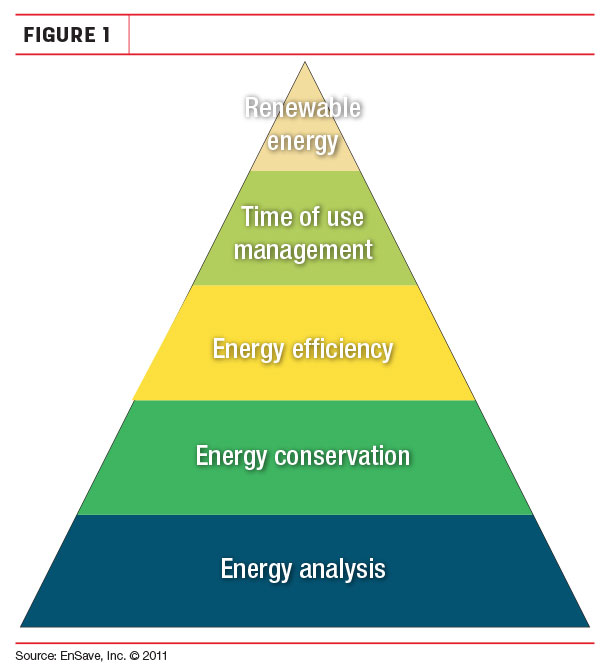If you have started to examine ways to reduce your energy costs on the farm, you have probably found a lot of information about ways to cut energy use. Some of this information can be confusing or conflicting, especially when you are trying to find out which practices give you the best “bang for your energy buck.”
To help sort out your priorities for energy management, it’s wise to keep the “energy pyramid” model in mind (Figure 1).

The energy pyramid describes a cost-effective approach to minimizing energy costs and achieving greater energy independence. In some cases, too much emphasis is placed on renewable energy to address energy concerns.
Rather than being the first course of action, renewable energy should typically be considered only after addressing energy analysis, energy conservation, energy efficiency and time of use management. This approach will minimize design and implementation costs associated with renewable energy technologies – and that helps you make the wisest use of your investment.
Below, we describe each step of the pyramid. Dairy producers who are seeking to cost-effectively minimize their energy expenses should begin with energy analysis to identify opportunities for energy cost savings.
Analysis is then followed by implementing the identified opportunities, beginning with the simplest and least expensive before pursuing the most complex and costly.
Energy analysis
Energy analysis provides a foundation for understanding cost-effective energy management and is an essential step toward reducing energy usage. An energy audit or assessment will identify opportunities to reduce energy costs and help prioritize upgrades by providing simple payback periods for energy efficiency measures and practices.
Energy conservation
Energy conservation is typically achieved through behavioral changes. Examples include turning off lights if no one is using them, unplugging unused equipment and turning thermostats lower in the winter or higher in the summer. Behavioral changes are free but have a limited impact on energy use reduction.
Energy efficiency
Energy efficiency means using energy more effectively to achieve the same level or a greater level of performance while using less energy. Energy efficiency is often accomplished through technological changes, such as upgrading lights, fans, motors or pumps with more efficient replacements.
Time of use management
Electricity costs often vary over the course of the day. Running equipment during peak hours can be costly due to peak energy charges and demand charges. By running equipment during off-peak hours and reducing peak demand, energy costs can often be considerably reduced. Examples include shifting irrigation or milking to off-peak hours.
Renewable energy
The last step toward achieving energy independence is utilizing renewable energy technologies, which generate energy from naturally replenished sources for use on the farm. Examples include anaerobic digesters, solar photovoltaic, solar thermal, geothermal and wind turbines.
Now that you see the benefits of energy efficiency as one of the lowest-cost ways to immediately reduce your energy costs, let’s take a closer look at some common energy efficiency technologies. While there are many other energy efficiency technologies, the equipment below tends to have the shortest payback.
An energy efficiency measure is typically a good choice if the energy savings exceed the cost of the equipment before the end of its useful life. With many technologies lasting 10 to 20 years, you can look at any piece of equipment with a simple payback less than this as a good investment. However, you must of course consider the specific situation of your farm.
Energy-efficient equipment may have other benefits, such as a productivity increase or labor savings, that make them a good choice despite a longer payback period. To understand the technologies that best apply to your farm, and the payback period based on your specific operation, consider having a professional farm energy audit to analyze your energy consumption and make recommendations.
The USDA Natural Resources Conservation Service has funding available for energy audits which will enable you to apply for additional financial assistance for energy-efficient equipment. This funding can substantially reduce the initial cost of your new equipment, which will shorten your payback period.
The USDA Rural Development also has grant and loan funding available for energy-efficiency technologies, and funding could also be available through your utility company or various state agencies.
Lighting
If you have lighting on the farm that is not light-emitting-diode (LED), then it’s probably time for a replacement. LEDs typically consume 50 to 75 percent less energy than standard lighting fixtures such as incandescent, mercury vapor, metal halide, high-pressure sodium and halogen.
They also have a longer fixture life, lower maintenance costs and no mercury in the fixture. Depending on the type of LED and the length of time your lighting is typically in use, most LEDs have a simple payback between one and five years.
Milk vacuum pump variable frequency drive (VFD)
On average, vacuum pumps consume 15 to 25 percent of a dairy farm’s electricity. A milk vacuum pump VFD is a digital controller that measures vacuum demand from the milking line and regulates the speed of the pump motor accordingly rather than running the motor at a constant high speed. A milk vacuum pump VFD provides a payback of between three and seven years.
Plate cooler
A well water plate cooler can considerably reduce milk cooling loads. Plate coolers are a set of stainless steel plates installed in the milk line between the receiver vat and the bulk tank. Well water passes through the plate cooler in one direction and absorbs heat from milk passing in the opposite direction. Plate coolers typically have a simple payback of three to five years.
Milk transfer pump VFD
When coupled with a milk pump VFD, even more savings can be realized through the plate cooler. A milk pump VFD regulates the milk flow over the plates, thereby allowing time for maximum cooling to take place. The ideal milk transfer would pump the milk at the slowest and most constant rate possible through the plate cooler.
Tests have shown energy savings for the milk cooling system of up to 30 percent when the milk pump is controlled by a VFD coupled with a plate cooler.
High-efficiency compressors
As they age, compressors lose efficiency. One simple way to improve the efficiency of milk cooling systems is to replace conventional compressors with scroll compressors (up to 10 horsepower) or discus compressors (over 10 horsepower). They have a typical payback of five to seven years.
Compressor heat recovery
Compressor heat recovery units are insulated storage tanks that use waste heat from the bulk tank and chiller compressors to pre-heat water to approximately 110ºF before it enters a conventional water heater. This process cuts water heating costs by up to 50 percent and can extend the life of your refrigeration system.
The typical simple payback for a compressor heat recovery unit is two to five years. ![]()

-
Kyle Booth
- Engineering Team Lead, CEM
- EnSave Inc.
- Email Kyle Booth






